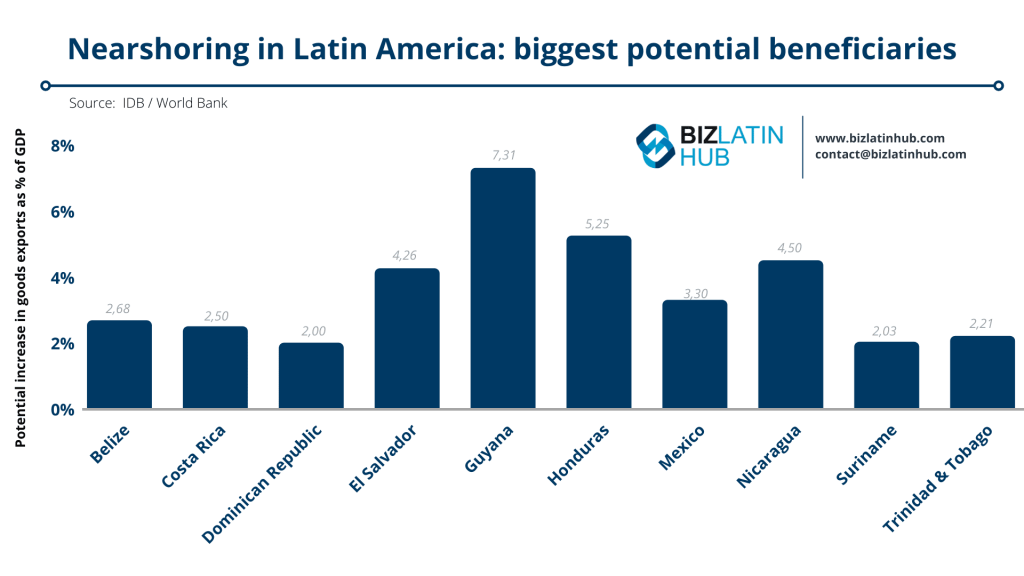Nearshoring in Latin America has become a popular business strategy in recent years, especially for companies looking to manage costs while still maintaining quality. The region has emerged as a promising option for companies that are seeking to outsource their operations to a friendly and stable nearby country or to expand business opportunities in the region.
The process involves outsourcing business processes to a nearby country or region, rather than a distant location such as India or China. Nearshoring in Latin America specifically is gaining significant traction from North American businesses due to its immense benefits. These include, but are not limited to, lower costs, similar time zones, and cultural similarities that streamline communications.
Further attractions of nearshoring in Latin America include its highly skilled workforce and proximity to the United States. Many companies are choosing to nearshore to countries such as Mexico, Costa Rica, and Colombia, which offer a range of benefits. Biz Latin Hub can help you with company formation in the region and support you through your company’s life cycle with our range of back office services.

7 Benefits of nearshoring in Latin America
Here are the main benefits this region brings to businesses trying to expand into new markets.
- Cost savings
- Time zones
- Cultural similarities
- Highly skilled workforce
- Proximity to the United States
- Favorable business environment
- Access to new markets
Let’s go specifically into each one of these points.

1. Cost savings
Nearshoring in Latin America is often less expensive than outsourcing to other regions, such as Asia. This is because labor costs are often lower, and companies can take advantage of favorable exchange rates to further reduce costs.
2. Similar time zones
Latin America is located in a similar time zone to the United States, which makes communication and collaboration easier. Teams can work together during regular business hours, which can improve productivity and reduce the risk of miscommunication.
3. Cultural similarities
Many countries in Latin America share similar cultural values and business practices with the United States. This makes it easier to work together and it can help minimize cultural differences that could impact productivity and communication.
4. Highly skilled workforce
Thanks to regionwide investments in education and training, nearshoring in Latin America gives access to a highly skilled workforce. Companies can access top talent at a lower cost than they would pay in the United States.
5. Proximity to the United States
Latin America is located close to the United States, which makes it easier to travel for business meetings and other important events. This can help to strengthen relationships between companies and their nearshore partners.
6. Favorable business environment
Many countries in Latin America offer a favorable business environment, with supportive government policies and regulations that make it easier to do business. This can help companies to operate more efficiently and effectively.
7. Access to new markets
Nearshoring to Latin America can also provide companies with access to new markets. This can be especially important for companies that are looking to expand their customer base and explore new opportunities.
What are the best countries for nearshoring in Latin America?
The region has a range of options for nearshoring, each with its own advantages and strengths. Here are some of the best countries for nearshoring in Latin America:
- Mexico
- Costa Rica
- Colombia
- Brazil
- Argentina
- Chile
Let’s delve into what each one of these countries offer:
Mexico

This is one of the most popular destinations for any business looking to expand into the region. The country offers a large pool of highly skilled workers, a favorable business climate, and close proximity to the United States. Mexico has become a leading destination for nearshoring in the manufacturing, technology, and service sectors.
Mexico’s economy is also stable and growing, with a GDP that is expected to increase in the coming years. This provides a secure business environment for companies looking to invest in nearshoring operations. The country also has several favorable trade agreements, including the USMCA (formerly NAFTA), which provides companies with duty-free access to the US and Canadian markets.
Costa Rica
Costa Rica is another popular destination for nearshoring in Central America. The country offers a highly educated workforce, political stability, and a favorable business environment. Costa Rica has become an especially popular destination for nearshoring in the technology and service sectors. With both Atlantic and Pacific coastal ports, the country can ship both east and west with ease.
Colombia
Colombia is also emerging as a key player for nearshoring in South America. The country offers a highly skilled workforce, a favorable business environment, and a large pool of English-speaking workers. There is a vibrant startup ecosystem and a growing technology industry, making it an ideal destination for companies looking to tap into the region’s innovation potential.
Brazil
Brazil is the largest economy in Latin America and offers a range of advantages for nearshoring, including a large and diverse workforce, a strong infrastructure, and a favorable business climate. Brazil is a popular destination for nearshoring in the technology, manufacturing, and service sectors.
Additionally, it makes a great destination for businesses that have a more Portuguese-language approach. It’s the official language of Brazil, which makes it a desirable destination for companies looking to serve Portuguese-speaking markets in South America, Africa, and Europe. On top of that, there’s an enormous internal market.
Argentina
Argentina also offers a great workforce, a favorable business environment, and a strong focus on innovation and technology. The country has a large and growing technology sector, with a thriving startup culture and numerous incubators and accelerators to support new businesses. This means that companies looking to nearshore to Argentina can easily find local partners and suppliers to help them get started.
Chile
Chile offers a very stable political environment and a number of Pacific ports which enable goods to be easily shipped up the coast to North America. The country is a member of a number of free trade agreements, meaning super smooth commercial links not just regionally but worldwide. It also benefits from good infrastructure and a superb education system.
FAQs when nearshoring in Latin America
How can I make nearshoring successful?
- Build relationships.
- Understand the legal environment.
- Be prepared for bureaucracy.
- Embrace the culture.
- Focus on sustainability.
What is nearshoring in Latin America?
Nearshoring in Latin America refers to the practice of outsourcing business processes or services to companies that are geographically close to the business’s home country. It involves transferring tasks or projects to a nearby country, often in the same or similar time zone, rather than outsourcing them to a distant location.
How does nearshoring in Latin America compare to farshoring in terms of cost?
Nearshoring to Latin America offers competitive prices and proximity to the United States, making it a cost-effective alternative to farshoring.
How to apply nearshoring in Latin America?
- Assess needs: Evaluate which processes or services can be nearshored based on requirements and feasibility.
- Research partners: Identify potential nearshore partners in Latin America with experience and expertise.
- Establish communication: Set up clear communication channels for collaboration and project management.
- Define expectations: Clearly outline expectations, goals, and deliverables for the nearshored project.
- Monitor performance: Continuously monitor partner performance to ensure alignment with your standards.
Are there any time zone advantages when nearshoring in Latin America?
Yes, nearshoring in Latin America means you are on a similar time to much of North America.
How can Biz Latin Hub help you with nearshoring in Latin America?
At Biz Latin Hub, we have a multilingual team for legal, accounting, recruitment, and company formation services, ready and waiting to support your business efforts such as nearshoring in Latin America and the Caribbean region.
Our broad range of services allow our clients to do business with the peace of mind that they have checked all the commercial boxes, and that they are compliant with all the relevant legislative and regulatory criteria.
To learn more about how we can assist you in doing business in Latin America, contact us.





